The Books of David G. Hartwell: Visions of Wonder and The Science Fiction Century
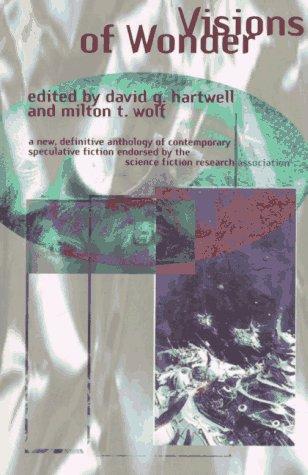 |
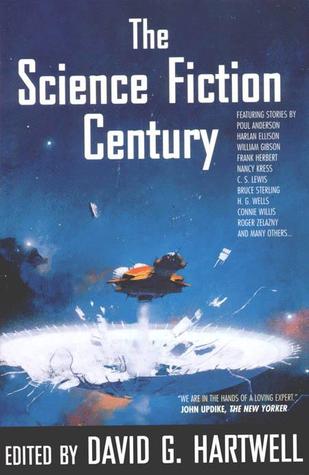 |
We lost David Hartwell on January 20th. This is our sixth article in a series that looks back at one of the most gifted editors in our industry.
With the publication of The Dark Descent and The Ascent of Wonder, David quickly established himself as the go-to guy for big genre survey volumes, and he produced many of them. These massive books were popular with libraries and book clubs, and many stayed in print for years. David had found a fine niche for himself that showed off his considerable talents for genre scholarship (not to mention his excellent taste), and he continued to compile these giant books for the rest of his life.
His next two major anthologies were huge science fiction retrospectives. The first, Visions of Wonder (1996), weighing in at a mere 798 pages, was co-edited with Milton T. Wolf, Vice President of the Science Fiction Research Association, and was a fine attempt to create an up-to-date SF textbook, mixing in critical essays by Damon Knight, John W. Campbell, Jr., Judith Merril, Samuel R. Delany, and others — plus a comprehensive guide to modern SF scholarship compiled by Gary K. Wolfe — with a generous sample of top-notch fiction. The 1005-page The Science Fiction Century (1997) was nothing less than a comprehensive survey of a hundred years of science fiction, containing works by H. G. Wells, C. S. Lewis, E. M. Forster, Rudyard Kipling, Jack London, A. E. van Vogt, Jack Vance, Robert Silverberg, Poul Anderson, Roger Zelazny, James Tiptree, Jr., Bruce Sterling, Nancy Kress, William Gibson, and dozens of others.
Here’s the back covers for both volumes.
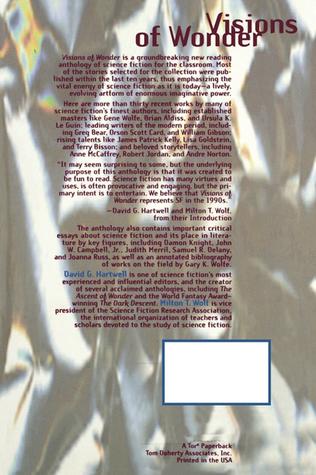 |
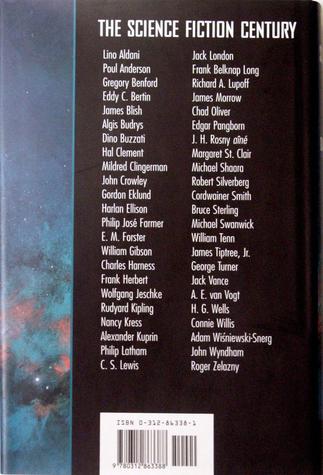 |
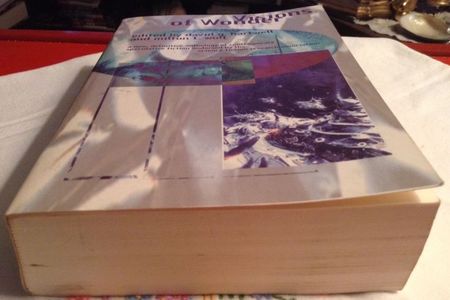 I don’t know how successful Visions of Wonder was as a textbook, but David also meant it to be a fun volume for readers, and it is a delight to browse. I have a few volumes of SF criticism on my shelves, but truthfully, nothing I tend to come back to very often. Visions of Wonder was the book that reminded me that SF criticism can be just as vital (and delightful to read) as our best fiction.
I don’t know how successful Visions of Wonder was as a textbook, but David also meant it to be a fun volume for readers, and it is a delight to browse. I have a few volumes of SF criticism on my shelves, but truthfully, nothing I tend to come back to very often. Visions of Wonder was the book that reminded me that SF criticism can be just as vital (and delightful to read) as our best fiction.
Here’s a taste from Damon’s Knight’s article Critics, for example, originally published in his seminal 1956 work In Search of Wonder.
What we get from science fiction — what keeps us reading it, in spite of our doubts and our occasional disgust — is not different from the thing that makes mainstream stories rewarding, but only expressed differently. We live on a minute island of known things. Our undiminished wonder at the mystery which surrounds us is what makes us human. In science fiction we can approach that mystery, not in small, everyday symbols, but in big ones of space and time.
Visions of Wonder makes a fine intro to some of the more popular authors and series in SF. Among much other fine fiction, it also contains a Berserker tale by Fred Saberhagen (1965), “Ender’s Game,” the first Ender Wiggin story by Orson Scott Card, a Newford novelette by Charles de Lint, “The Ship Who Sang,” the first Ship story by Anne McCaffrey — and even an excerpt from Robert Jordan’s The Eye of the World.
My usual complaint with survey volumes of this sort is that they tend to favor shorter tales, which make quick classroom assignments, over longer ones. But the editors don’t stint at all on longer fiction, packing in no less than five classic novellas:
“Mr. Boy” by James Patrick Kelly
“The Death of Doctor Island” by Gene Wolfe
“Souls” by Joanna Russ
“Wall, Stone, Craft” by Walter Jon Williams
“True Names” by Vernor Vinge
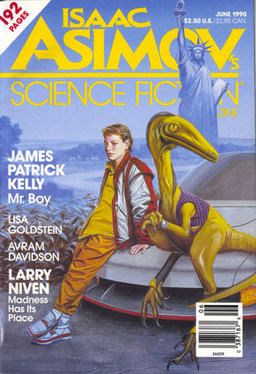 Here’s the complete Table of Contents.
Here’s the complete Table of Contents.
Introduction by David G. Hartwell and Milton T. Wolf
Critics by Damon Knight (In Search of Wonder, 1956)
“The Ship Who Sang” by Anne McCaffrey (The Magazine of Fantasy and Science Fiction, April 1961)
“Blood Music” by Greg Bear (Analog, June 1983) — Hugo & Nebula Award
Paperjack by Charles de Lint (Cheap Street, 1991) — World Fantasy nominee
“Forever Yours, Anna” by Kate Wilhelm (Omni, July 1987) — Nebula Award, Hugo nominee
The Golden Age of Science Fiction Is Twelve, by David G. Hartwell (1984)
“Mr. Boy” by James Patrick Kelly (Isaac Asimov’s Science Fiction Magazine, June 1990) — Nebula nominee
“Jamboree” by Jack Williamson (Galaxy, December 1969)
“The Death of Doctor Island” by Gene Wolfe (Universe 3, October 1973) — Nebula & Locus Award, Hugo nominee
“Ender’s Game” by Orson Scott Card (Analog, August 1977) — Hugo nominee
What Do You Mean … Human? by John W. Campbell, Jr. (Astounding, September 1959)
“Bears Discover Fire” by Terry Bisson (Isaac Asimov’s Science Fiction Magazine, August 1990) — Hugo, Locus, Nebula, Sturgeon Award, World Fantasy nominee
“One Down, One to Go” by Philip José Farmer (The Magazine of Fantasy & Science Fiction, October 1990)
“Sur” by Ursula K. Le Guin (The New Yorker, February 1, 1982) — Locus Award, Hugo nominee
Introduction by Judith Merril (England Swings SF, 1968)
“Doing Lennon” by Gregory Benford (Analog, April 1975) — Hugo & Nebula nominee
“A Tupolev Too Far” by Brian W. Aldiss (Other Edens III, 1989)
“Them Old Hyannis Blues” by Judith Tarr (Alternate Kennedys, July 1992)
Paradise Charted by Algis Budrys (TriQuarterly 49, 1980)
“Masque of the Red Shift” by Fred Saberhagen (If, November 1965) — Nebula nominee
“Redemption in the Quantum Realm” by Frederik Pohl (Asimov’s Science Fiction, April 1994)
“Devil You Don’t Know” by Dean Ing (Analog, January 1978) — Hugo & Nebula nominee
The Eye of the World (extract) by Robert Jordan (1990)
“Split Light” by Lisa Goldstein (Travellers in Magic, December 1994)
Science Fiction & The Adventures of the Spherical Cow by Kathryn Cramer (1988)
“The Sun Spider” by Lucius Shepard (Isaac Asimov’s Science Fiction Magazine, April 1987)
Science Fiction and “Literature” — or, The Conscience of the King by Samuel R. Delany (Minicon speech, first published in Analog, May 1979)
“Souls” by Joanna Russ (The Magazine of Fantasy & Science Fiction, January 1982) — Hugo & Locus Award, Nebula nominee
“Overdrawn at the Memory Bank” by John Varley (Galaxy, May 1976)
“The Girl Who Was Plugged In” by James Tiptree, Jr. (New Dimensions 3, October 1973) — Hugo Award, Nebula nominee
“Burning Chrome” by William Gibson (Omni, July 1982) — Nebula nominee
Towards an Aesthetic of Science Fiction by Joanna Russ (Science Fiction Studies, June 1976)
“Identifying the Object” by Gwyneth Jones (Interzone 42, December 1990)
“The Mountain to Mohammed” by Nancy Kress (Isaac Asimov’s Science Fiction Magazine, April 1992) — Hugo & Nebula nominee
“Wall, Stone, Craft” by Walter Jon Williams (The Magazine of Fantasy & Science Fiction, October-November 1993) — Hugo, Nebula, World Fantasy nominee
“Boobs” by Suzy McKee Charnas (Isaac Asimov’s Science Fiction Magazine, July 1989) — Hugo Award, Nebula nominee
To Bring in Fine Things: The Significance of Science Fiction Plots by Brian Stableford (The New York Review of Science Fiction, May 1989)
“Spider Silk” by Andre Norton (Flashing Swords 3, August 1976)
“A Braver Thing” by Charles Sheffield (Isaac Asimov’s Science Fiction Magazine, February 1990) — Hugo nominee
“Getting Real” by Susan Shwartz (Newer York, June 1991) — Nebula nominee
“True Names” by Vernor Vinge (Binary Star No. 5, February 1981) — Hugo & Nebula nominee
Science Fiction: A Selective Guide to Scholarship by Gary K. Wolfe
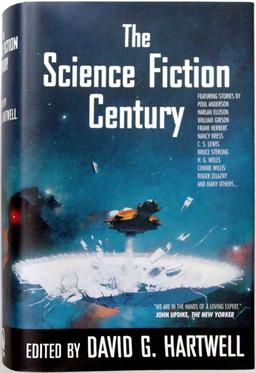 Visions of Wonder was published by Tor Books in November 1996, simultaneously in hardcover and trade paperback. The hardcover is 798 pages, priced at $35. It has now been out of print for 20 years, and there is no digital edition.
Visions of Wonder was published by Tor Books in November 1996, simultaneously in hardcover and trade paperback. The hardcover is 798 pages, priced at $35. It has now been out of print for 20 years, and there is no digital edition.
The Science Fiction Century appeared a year later. An even bigger volume, it made no attempt at scholarship beyond a four-page intro by Hartwell. It is purely a reader’s delight, one of David’s best anthologies, a marvelously comprehensive look at a hundred years of top-notch SF. Here’s the description from the jacket flap:
“Science fiction is the characteristic literary genre of the century. It is the genre that stands in opposition to literary modernism.” So says David G. Hartwell in his introduction to The Science Fiction Century, an anthology spanning a hundred years of science fiction, from its birth in the 1890s to the future it predicted.
David G. Hartwell is a World Fantasy Award-winning editor and anthologist who has twice before redefined a genre — first the horror field with The Dark Descent, then the subgenre of hard science fiction with The Ascent of Wonder, coedited with Kathryn Cramer. Now, Hartwell has compiled the mother of all definitive anthologies, guaranteed to change not only the way the science fiction field views itself but also the way the rest of literature views the field.
The Science Fiction Century includes stories from the founding fathers of the field, such as H.G. Wells, C.S. Lewis, Jack London, and Rudyard Kipling; beloved mainstays of the genre, such as Philip José Farmer, Roger Zelazny, Jack Vance, and Poul Anderson; noted female writers, including Connie Willis, Nancy Kress, and James Tiptree, Jr.; and writers who have hit their stride in the last two decades, such as Bruce Sterling, William Gibson, Michael Swanwick, and James Morrow. Hartwell has also included writers widely recognized outside the genre, such as E.M. Forster, Michael Shaara, and John Crowley; and translations of foreign writers’ formative works, including Dino Buzzati and Wolfgang Jeschke. This is must-have anthology for all literary interests.
As mentioned in the description, David looked beyond English SF to fill out this volume, reprinting a half-dozen stories in translation. It’s also crammed full of award-winning SF from the top names in the genre, including James Blish, Algis Budrys, Michael Swanwick, William Tenn, Frank Herbert — and the very first story by James Tiptree, Jr.
There’s an Instrumentality of Mankind story by Cordwainer Smith, a Shaper/Mechanist novelette by Bruce Sterling, a Space War Blues short story by Richard A. Lupoff, and a Sleepless novella by Nancy Kress.
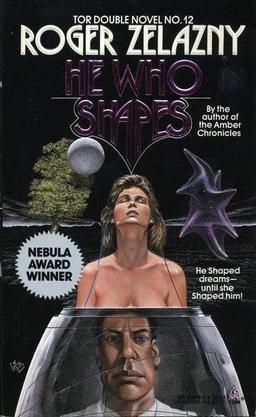 Speaking of novellas, with so much space to play in David is once again generous with longer fiction, including no less than ten novellas:
Speaking of novellas, with so much space to play in David is once again generous with longer fiction, including no less than ten novellas:
“A Story of the Days to Come” by H. G. Wells
“The Rose” by Charles L. Harness
“The King and the Dollmaker” by Wolfgang Jeschke
“The Scarlet Plague” by Jack London
“Great Work of Time” by John Crowley
“Rumfuddle” by Jack Vance
“Consider Her Ways” by John Wyndham
“He Who Shapes” by Roger Zelazny
“Beggars in Spain” by Nancy Kress
“Blood’s a Rover” by Chad Oliver
Here’s the complete TOC.
Introduction by David G. Hartwell
“Beam Us Home” by James Tiptree, Jr. (Galaxy Magazine, April 1969)
“Ministering Angels” by C. S. Lewis (Saturday Review of Literature, May 28, 1955)
“The Music Master of Babylon” by Edgar Pangborn (Galaxy Science Fiction, November 1954)
“A Story of the Days to Come” by H. G. Wells (Pall Mall Magazine, 1899)
“Hot Planet” by Hal Clement (Galaxy Magazine, August 1963)
“A Work of Art” by James Blish (Science Fiction Stories, July 1956)
“The Machine Stops” by E. M. Forster (Oxford and Cambridge Review, November 1909)
“Brightness Falls from the Air” by Margaret St. Clair (The Magazine of Fantasy and Science Fiction, April 1951)
“2066: Election Day” by Michael Shaara (Astounding Science Fiction, December 1956)
“The Rose” by Charles L. Harness (Authentic Science Fiction Monthly #31, March 1953)
“The Hounds of Tindalos” by Frank Belknap Long (Weird Tales, March 1929)
“The Angel of Violence” by Adam Wiśniewski-Snerg (1978; translated from the Polish)
“Nobody Bothers Gus” by Algis Budrys (Astounding Science Fiction, November 1955) — Hugo nominee
“The Time Machine” by Dino Buzzati
“Mother” by Philip José Farmer (Thrilling Wonder Stories, April 1953)
“As Easy as A.B.C.” by Rudyard Kipling (The London Magazine, March 1912)
“Ginungagap” by Michael Swanwick (TriQuarterly 49, 1980) — Nebula nominee
“Minister Without Portfolio” by Mildred Clingerman (The Magazine of Fantasy and Science Fiction, February 1952)
“Time in Advance” by William Tenn (Galaxy Science Fiction, August 1956)
“Good Night, Sophie” by Lino Aldani (1963, translated from the Italian in 1973)
“Veritas” by James Morrow (Synergy: New Science Fiction, Number 1, 1987)
“Enchanted Village” by A. E. van Vogt (Other Worlds Science Stories, July 1950)
“The King and the Dollmaker” by Wolfgang Jeschke (1961, translated 1970)
“Fire Watch” by Connie Willis (Isaac Asimov’s Science Fiction Magazine, February 1982) — Hugo & Nebula Award
“Goat Song” by Poul Anderson (The Magazine of Fantasy and Science Fiction, February 1972) — Hugo & Nebula Award
“The Scarlet Plague” by Jack London (London Magazine, June 1912)
“Drunkboat” by Cordwainer Smith (Amazing Stories, October 1963)
“Another World” by J. H. Rosny aîné (1895, translated 1962)
“If the Stars Are Gods” by Gordon Eklund and Gregory Benford (Universe 4, March 1974) — Nebula Award
“I Still Call Australia Home” by George Turner (Aurealis #1, April 1990)
“Liquid Sunshine” by Alexander Kuprin (1913, translated from Russian in 1982)
“Great Work of Time” by John Crowley (Novelty, May 1989) — World Fantasy Award, Nebula nominee
“Sundance” by Robert Silverberg (The Magazine of Fantasy and Science Fiction, June 1969)
“Greenslaves” by Frank Herbert (Amazing Stories, March 1965)
“Rumfuddle” by Jack Vance (Three Trips in Time and Space: Original Novellas of Science Fiction, 1973)
“The Dimple in Draco” by R. S. Richardson (Orbit 2, June 1967)
“Consider Her Ways” by John Wyndham (Sometime, Never, 1956)
“Something Ending” by Eddy C. Bertin (1971, translated 1982)
“He Who Shapes” by Roger Zelazny (Amazing Stories, January 1965) — Nebula Award
“Swarm” by Bruce Sterling (The Magazine of Fantasy & Science Fiction, April 1982) — Hugo & Nebula nominee
“Beggars in Spain” by Nancy Kress (Isaac Asimov’s Science Fiction Magazine, April 1991) — Hugo & Nebula Award
“Johnny Mnemonic” by William Gibson (Omni, May 1981) — Nebula nominee
“Repent, Harlequin!” Said the Ticktockman” by Harlan Ellison (Galaxy Magazine, December 1965) — Hugo & Nebula Award
“Blood’s a Rover” by Chad Oliver (Astounding Science Fiction, May 1952)
“Sail the Tide of Mourning” by Richard A. Lupoff (New Dimensions 5, April 1975) — Hugo & Nebula nominee
The Science Fiction Century was published by Tor Books in November 1997. It is 1005 pages, priced at $40 in hardcover. The cover is by John Harris.
Tor/Orb published a trade paperback edition in two volumes in March and October of 2006, using classic pulp art for the covers. Here they are.
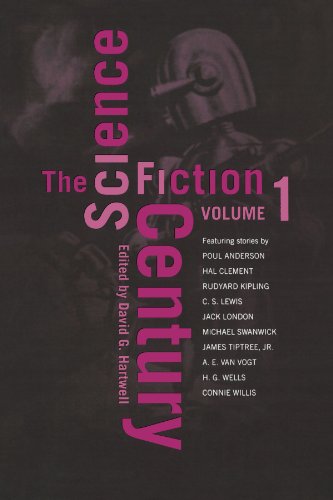 |
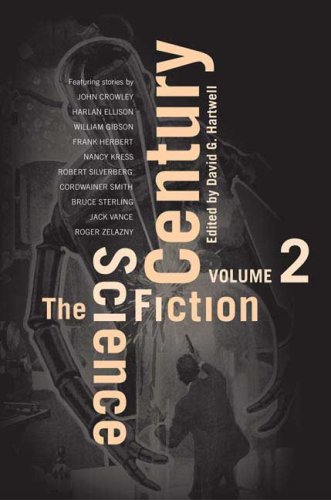 |
It is currently out of print. There is no digital edition.
The previous articles in our David Hartwell tribute series are:
The Masterpieces of Fantasy
The Dark Descent and The World Treasury of Science Fiction
The Early Horror Paperbacks
Foundations of Fear and The Ascent of Wonder
The Canadian Anthologies
Next up: David’s Renaissance volumes, The Hard SF Renaissance (2002) and The Space Opera Renaissance (2006), both co-edited with Kathryn Cramer
See all of our recent Vintage Treasures here.
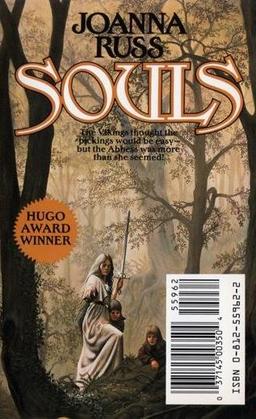
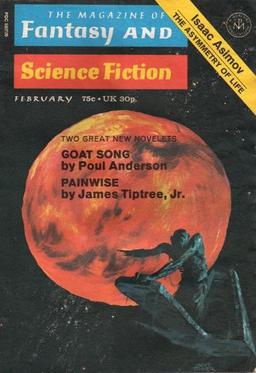
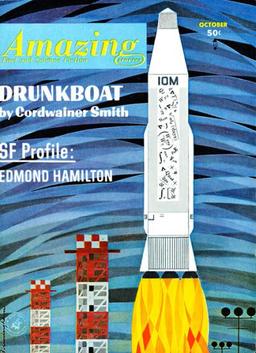
John, do you plan on doing any posts on Harwell’s non-fiction? I don’t know much of it but I read his The Futurians last year and really liked it.
I hadn’t planned on it, actually. But I should do at least one post on his magazine, The New York Review of SF.
[…] REQUESTING MORE CONTENTS, FEWER TABLES. Black Gate continues its Hartwell tribute with “The Books of David G. Hartwell: Visions of Wonder and The Science Fiction Century”. I’m all in favor of paying tribute to Hartwell, I’d just like to see more in these posts than […]
Dear god, I want _all_ of Hartwell’s anthologies to get eBook releases — just imagine how well-stocked one’s Kindle would be …